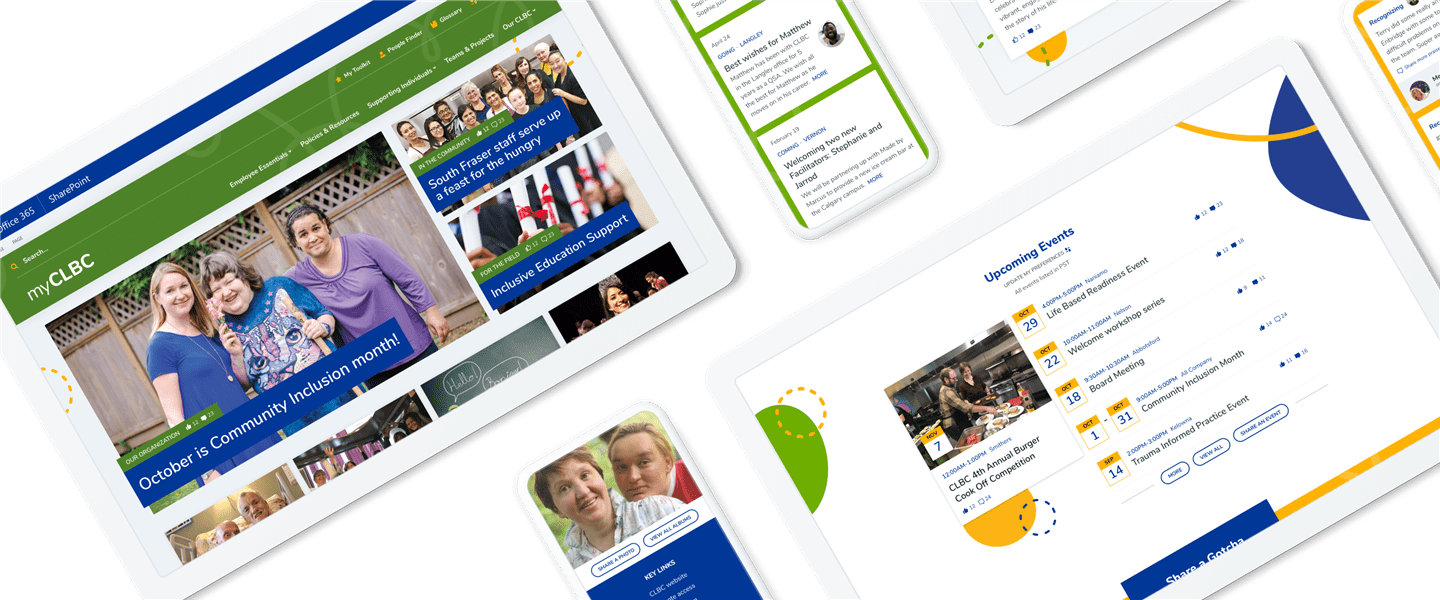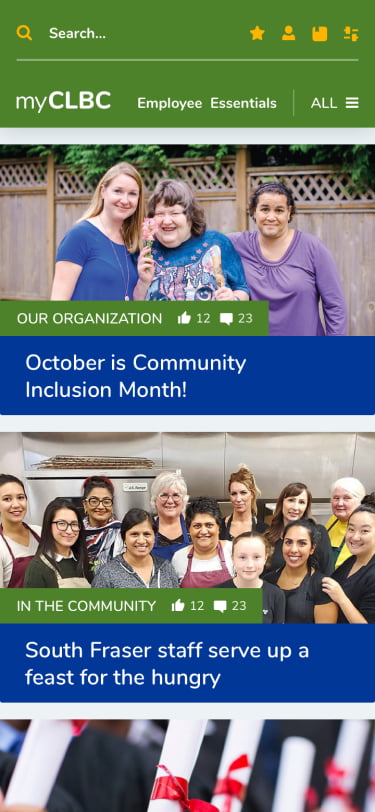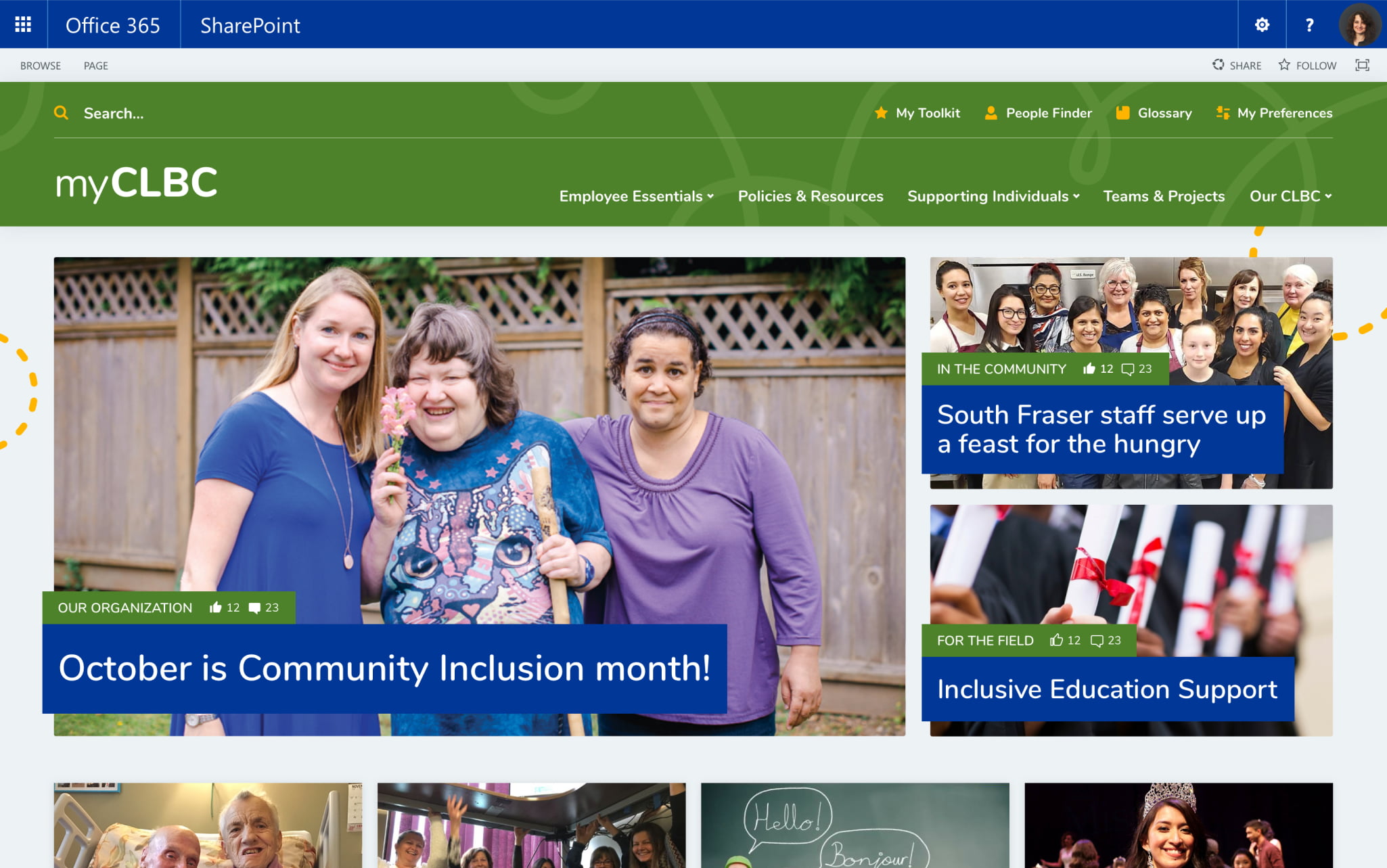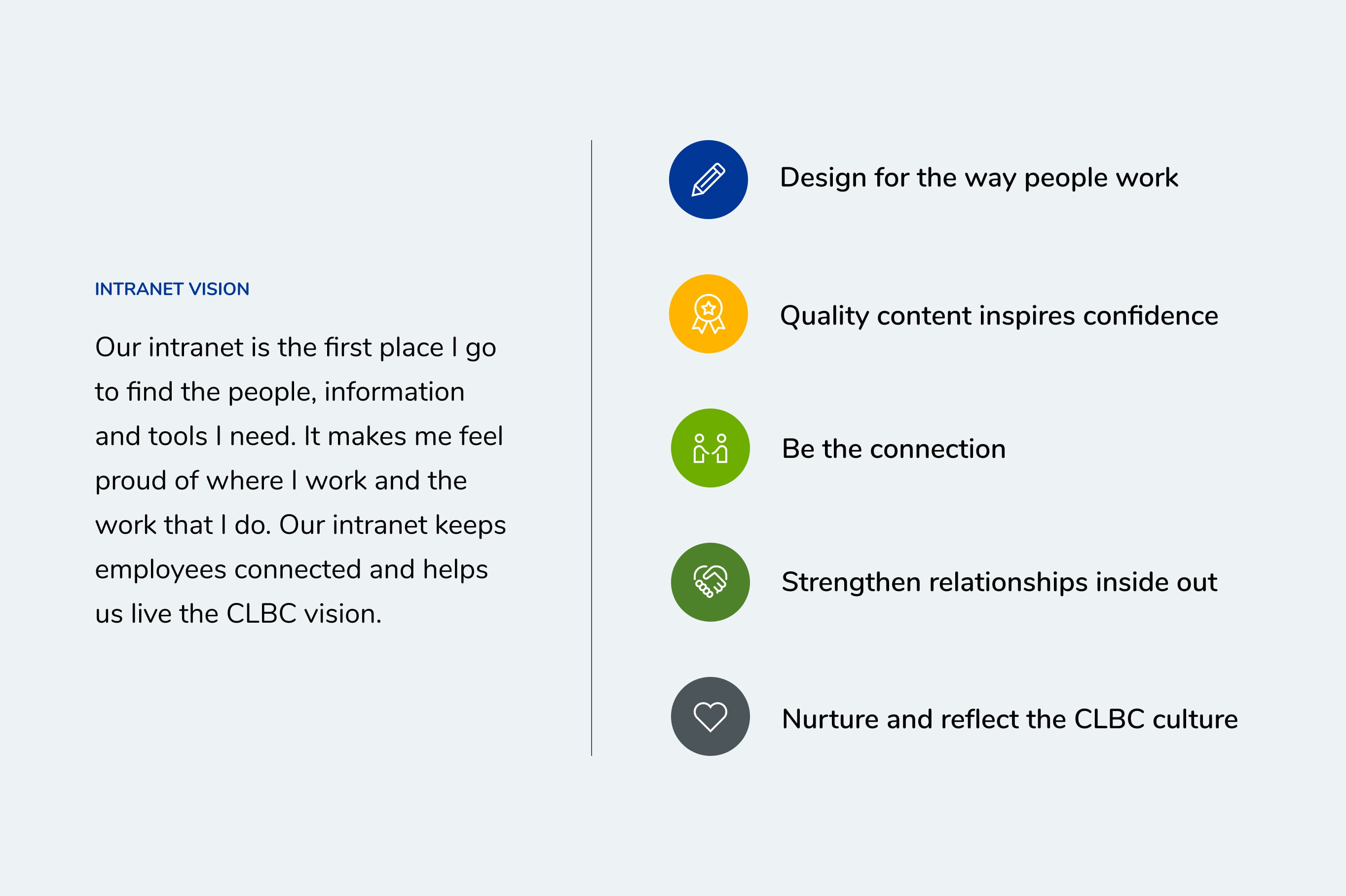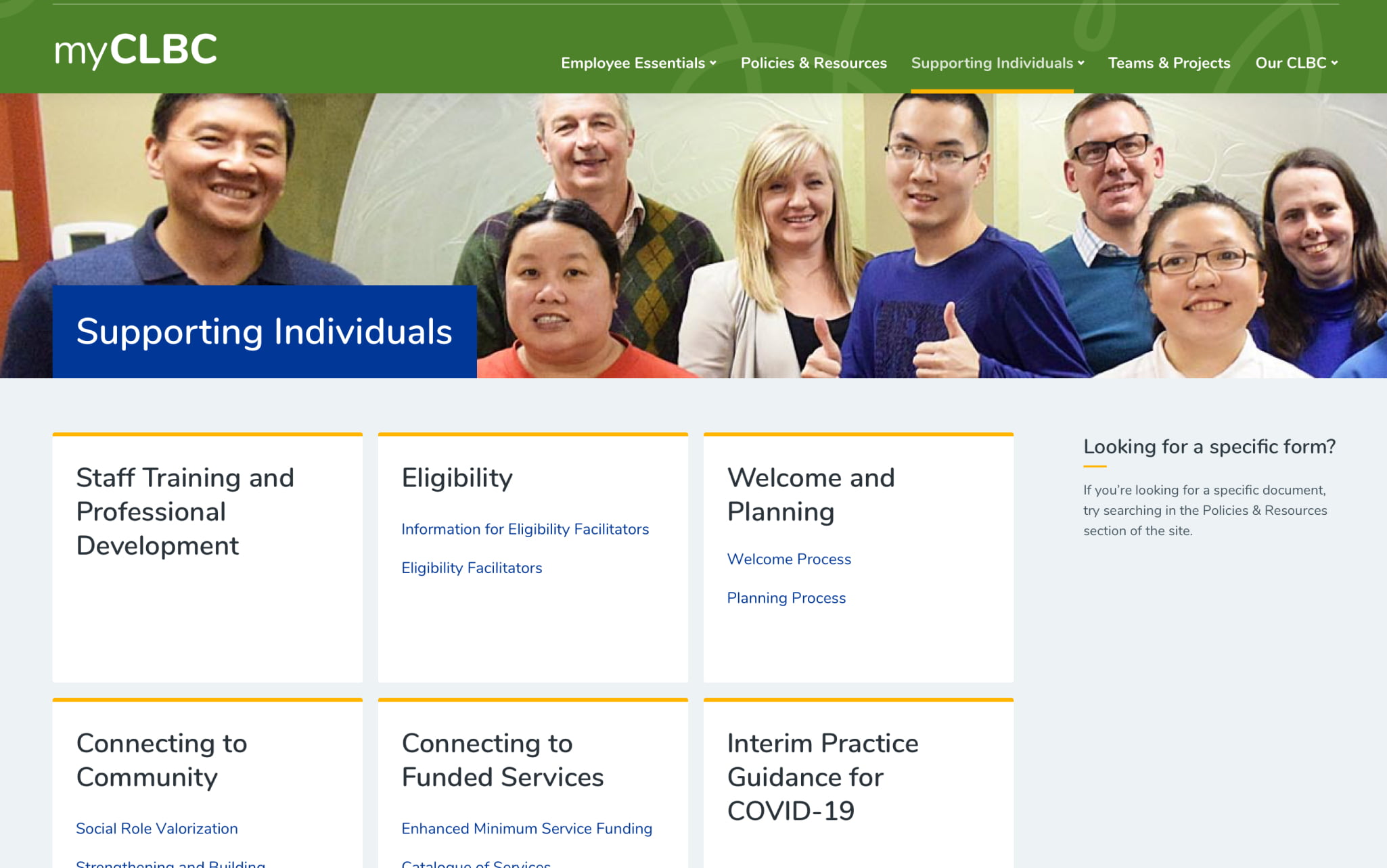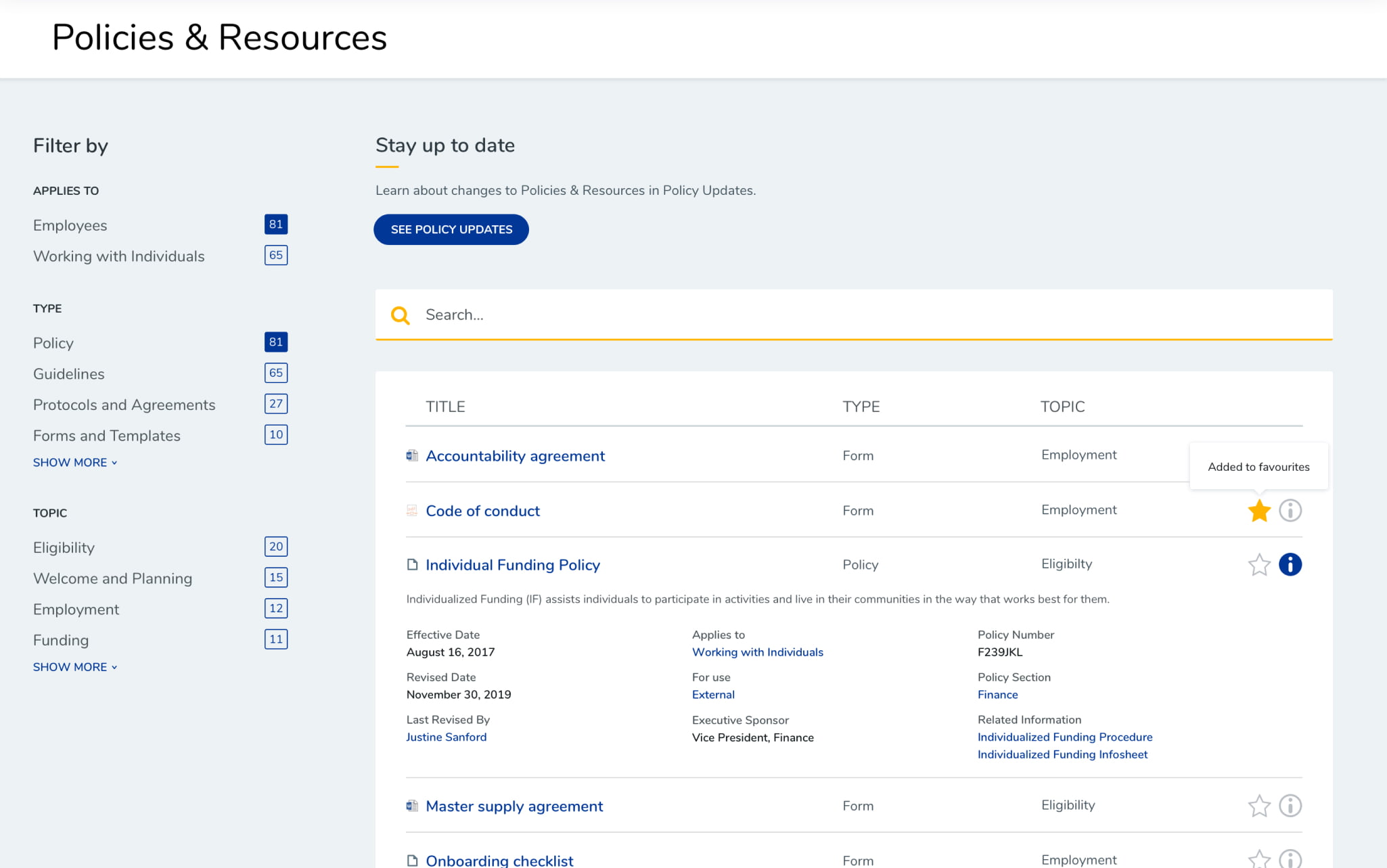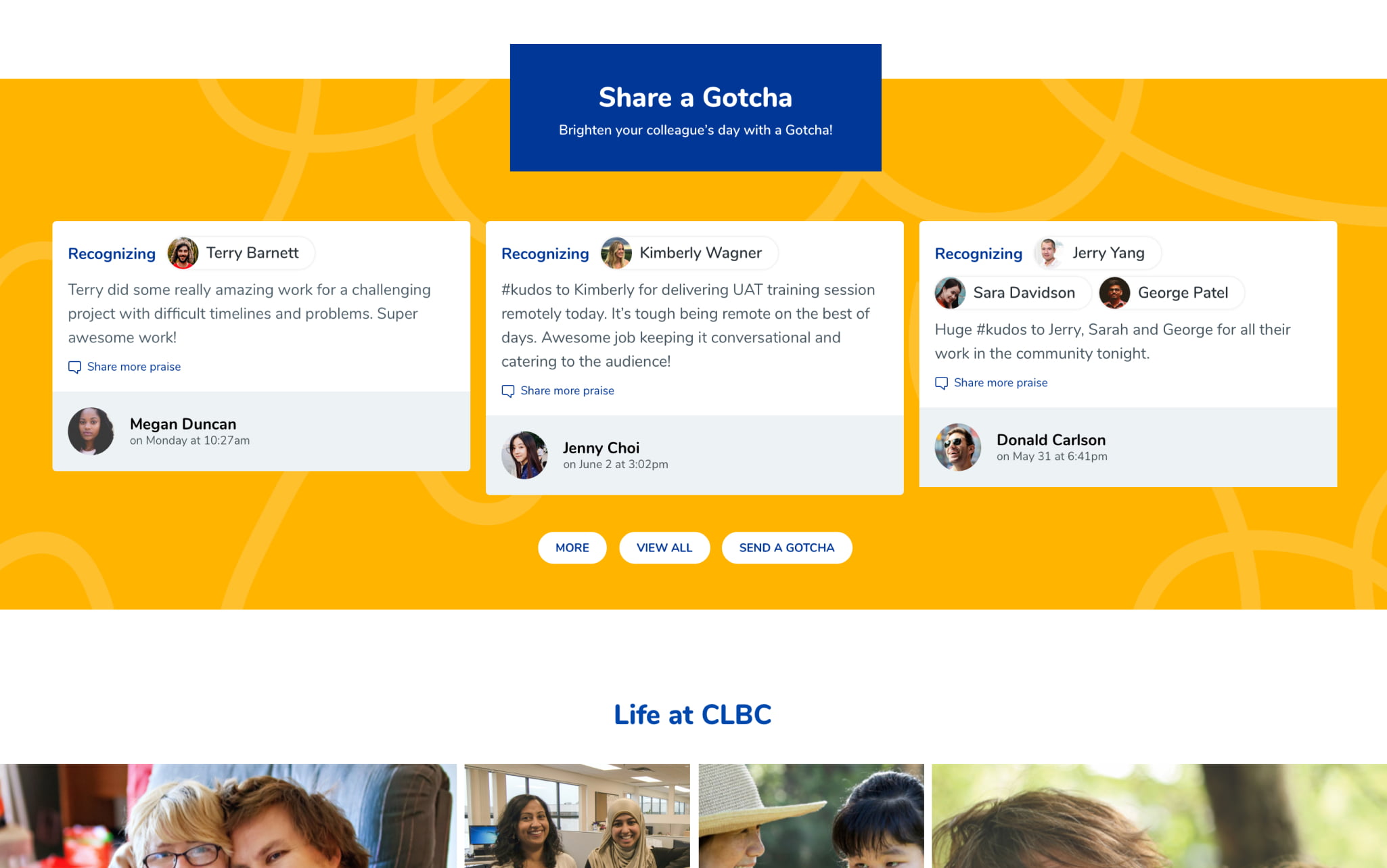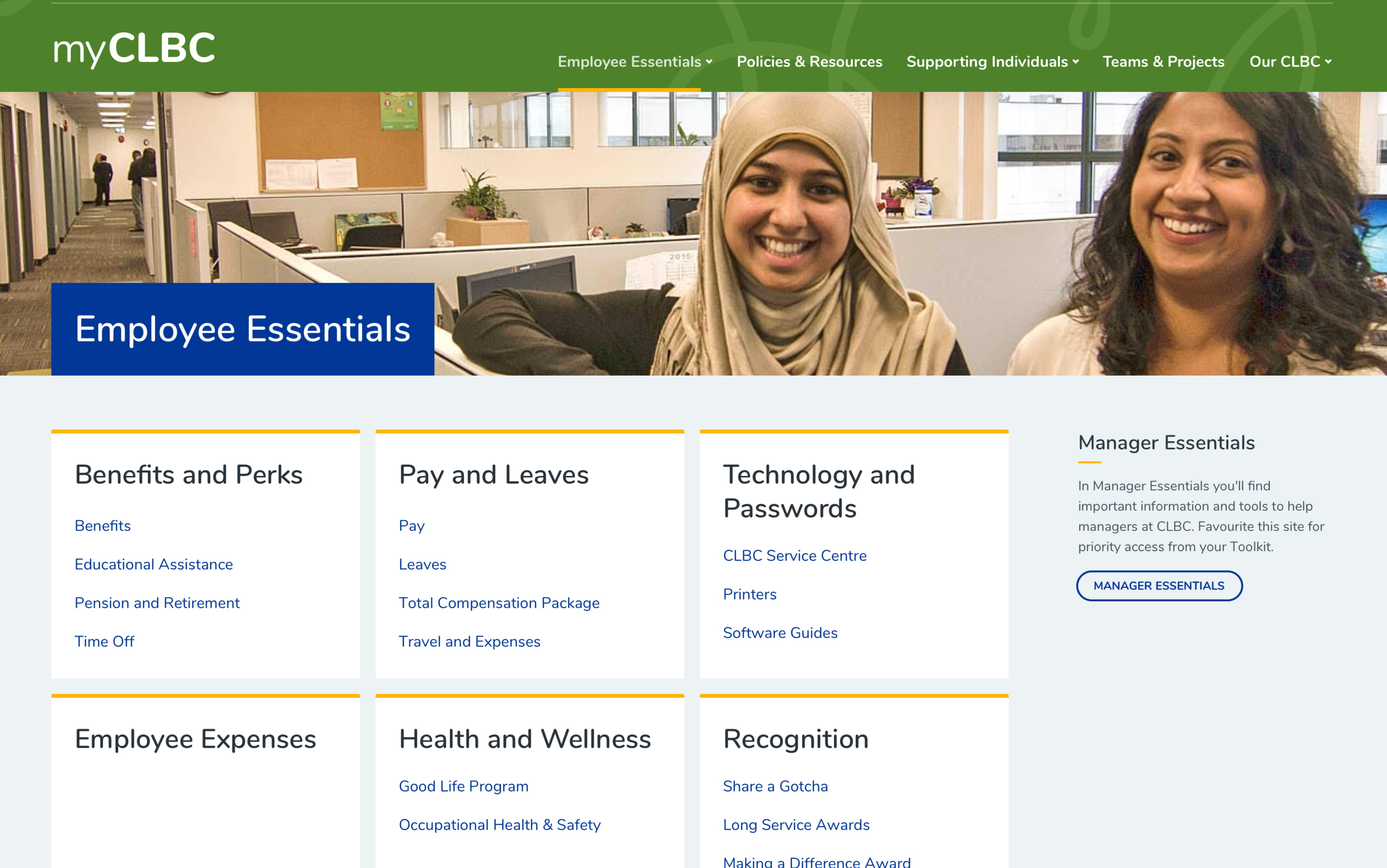The average employee tenure at Community Living BC (CLBC), a provincial agency that supports adults who have a developmental disability, is 10 years. Staff are deeply knowledgeable and committed to the work they do connecting individuals and families to community supports and services to help them have lives filled with possibilities in welcoming communities.
The organization’s nearly 600 employees are distributed across 37 regional offices and its Vancouver headquarters. Their work relies on easy access to accurate, up-to-date information, so they can provide quality, consistent service in communities across the province.
“Our staff identified the intranet as a top priority,” explains Randy Schmidt, executive director of communications and stakeholder relations at CLBC. “Having a consistent central place where people can go to find the information and tools they need is critical to support the quality and consistency of the work they do to serve individuals and families.”
At over a decade old, their previous intranet was nearing end-of-life. Its navigation and functionality were outdated; staff could find what they needed, but it took more time than they’d like. Head office had made the most of its limited capabilities to push information out to the field, and they were ready for an upgrade.
They had a vision to create myCLBC, a visual and accessible GO intranet, designed from the employee’s point of view. Sara Miller, vice president of information technology and workplace solutions at CLBC, explains: “We wanted to support two-way communication, foster an engaged and inclusive organizational culture, share CLBC’s vision and mission through news, and acknowledge and celebrate our staff for the small and the big things that they do every day.”
Supporting CLBC’s culture
The people who work at CLBC are drawn to supporting people to be included in their communities. “It’s a very heart-driven, caring culture, and our employees are very conscientious about the work that they do and very committed to it,” says Sara.
The organization engages with stakeholders, external and internal, as part of their continuous efforts to improve how they provide services to the individuals and families that they serve. It’s a core part of their culture to look ahead strategically at where they’re going, so they can anticipate and meet the needs of their constituents.
Staff embody this too in the way they approach their work. Sara describes them as resilient, creative and innovative. If there is a gap or need, they will come forward with interesting solutions that they built. “With our intranet, we’re trying to build a culture where that gets shared across the organization, so everyone can benefit from our shared expertise,” says Sara.
An employee-centred approach
At CLBC, they believe a strong employee experience drives better individual and family experiences. They looked for a partner aligned with their values; someone who would take more than a technical approach to their new intranet.
As Randy explains, “At CLBC, we have a very collaborative, collegial approach to things, and we're always seeking to get input from individuals and families. Internally, we try to do that with staff too. A lot of companies have really great technical solutions, but they lack the understanding of how those serve the bigger goal of actually supporting staff. Habanero didn't approach it from only a technical point of view; they were very oriented towards how the platform could support staff engagement and work.”
As part of the project’s research and discovery phase, CLBC engaged people from five regions of the organization as well as head office to understand what kind of functionality they needed in a new intranet. They identified two key front-line roles with distinct intranet needs:
- Facilitator – someone who works with individuals and families when they come to CLBC for services
- Analyst – someone who works with agencies that CLBC funds to deliver the services to families
Employees participated in listening labs and workshops, lead by Habanero Consultant Christina Ferancik, that helped the team gain a solid understanding what employees need from their intranet – everything from their dream wishlist down to what was immediately feasible.
CLBC employees were active participants in the design process. As Christina recalls, “We shared early versions of the intranet with employees through the design and build of myCLBC. The continuous feedback measurably improved the experience for employees. We aim to build a safe environment for them to share their experiences – the good, the bad and everything in between. Taking time to listen to employees is essential.”
Features that make work easier
The Habanero team helped CLBC define a scope that was achievable for their time frames and capacity. As Sara recalls, “Christina and her team mapped out what this journey could look like and how we could approach it. At every step, Habanero engaged us to ensure that diverse voices came to the table and that we had a comprehensive set of shared perspectives about what the intranet could look like and what was needed to move forward. They helped us prioritize the features we would have at go-live versus the ones that we could consider once we have more experience under our belts and have established some of those really important foundational components.” An intranet vision and design principles helped align the organization’s large and diverse group of stakeholders, so they could prioritize features to focus on what mattered most to them.
The organization’s fun, lively personality comes through in the design, thanks to Habanero Interaction Designer Hanah Lim. In usability testing, the bright colours, clean layout and real staff photos resonated strongly with testers.
Resources for field staff
The Supporting Individuals section was created as a rich learning resource for field staff to help them to do their jobs well, solve the problems they encounter and address whatever demands they're facing. It features information and resources staff need to complete key activities for their role, such as determining an individual’s eligibility for services, helping people to connect to resources in their community and contracting for services.
Enhanced policy centre
CLBC has a large library of policies and resources that provide guidance on how they serve people. David Pasko worked as a facilitator for seven years before transitioning to his current position as an analyst for provincial housing. He recalls his first experience with CLBC policies, so essential to his job: “When I first started CLBC, back in the day, everything was on paper, so you’d get a huge five-inch binder with all the policies!” Their process for storing and maintaining policies has evolved from those early days, and with their old intranet, CLBC had an intuitive system that worked well for them. With their GO intranet, they were able to take it to the next level, adding enhancements to help their employees find relevant documents quickly and easily.
Now the ability to search, find and track policies is more streamlined, and additional metadata provides rich details about each document and its related resources. Alerts let everyone know when a new policy is available or has been modified, and policy updates are tracked in an archive for easy reference. These new policy features support CLBC’s ongoing commitment to providing consistent and quality care to individuals and families.
Considerate social tools
Though the primary goal of the new intranet is to provide employees with the resources, tools and information they need to do their work, it also offers interactive features that allow them to connect with each other and discover what’s happening in other offices in a way that aligns with their culture. On the home page, people can share photos of what’s happening in their region, get updates on employee hires, transfers and retirement through Comings and Goings, and recognize and celebrate their colleagues by sharing a Gotcha.
“Although people were really excited about the interactive elements, like the Comings and Goings and Gotchas, quite a number of people asked us if there would be a review process before they would be posted,” Hanah recalls. “It was apparent to us that CLBC employees are very considerate of each other. They acknowledge that not everyone wants to be publicly recognized, and they don’t want people to feel compared to others based on how many comments or likes they receive.”
Custom content approvals for photos ensure that employees can feel comfortable about how their information is shared. The team also removed the option to “like” a Gotcha, and relabelled commenting to “share more praise” to encourage connection and engagement in a positive way.
Since the site launch, people have taken to the new feature. “In a large organization, sometimes people get missed,” says David. “There are people on our team who jump in to help, and nobody knows that they're doing that. I think the Gotchas are a really nice way to acknowledge them. We all need to hear about the exceptional people who go beyond their call of duty.”
Employee Essentials
The Employee Essentials section centralizes and surfaces content about employee supports, such as health and wellness programs, recognition programs, and education and career opportunities, in a way that’s easier for staff to find.
“On our old intranet, these were either minor sections or lists of links,” says Sara. “The new Employee Essentials section puts a spotlight on the programs and services people can access as an employee at CLBC.”
“It’s exciting to see the potential for our intranet to support our staff,” says Randy. “These areas have a lot of potential now that their structure and navigation are in place.”
A catalyst for change
The employee-centred, co-creative approach to launching their GO Intranet has spurred the organization to improve how they work together in other areas. “When you launch a new project to improve services, you have to bring together different parts of the organization to understand the policy guidance you need, the people who have to provide input, the tools that you need to make it happen and the training you need to put in place. It causes you to talk everything through and you end up revising and improving the ways you work,” says Randy.
They’ve also been retooling their change management approach as a result of their GO experience. “We are constantly required to make improvements to make changes to be responsive, so change management is critical in understanding how to prioritize,” says Randy. “To make change from a system point of view takes a lot of effort. It’s a key competency that is important for organizations like ours. This intranet has helped us learn how you can effect change in a responsive and relatively quick way in a large organization.”
Working better together
Since the launch of their new GO Intranet, usage has significantly increased, with the majority staff visiting myCLBC on a regular basis. “I think our approach of trying to build it around what the needs of our front-line workers has been well received,” Randy says. “It’s easier for people to find the things they need. We’re also able to deliver news in real time and post alerts if there's any important new policy guidance or issues that staff need to know.”
The sense of connection is growing too. Before, employees didn’t have a way of keeping up with their colleagues outside of occasional in-person meetings (pre-COVID). Now with the intranet, employees are sharing the comings and goings from every office, and everyone has a chance to feel more connected to the whole organization. People are able to upload photos of local events, like a charity drive or bake sale, and others can comment.
“There's life to it!” says David. “It helps speed up your job, and it reflects the direction of CLBC as a lively culture that’s more engaged at all levels.”
The intranet was especially useful immediately after its launch in late 2020, when many staff were still working remotely. “We were able to put short webinars and more engaging materials on the intranet than we would have been able to do on our old platform,” explains Sara. “It created a sense of connection that we weren't able to create with the old intranet. Even having the ability to put the alerts up, for example, around when offices had to close was very helpful. We were able to provide just-in-time communication and create an experience of connection at a time when we were physically very disconnected,” says Sara.
“This is a huge step forward for us,” says Randy.


